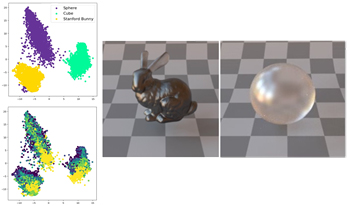References
1AndersonB. L.2011Visual perception of materials and surfacesCurr. Biol.21R978R983R978–8310.1016/j.cub.2011.11.022
2BellS.UpchurchP.SnavelyN.BalaK.2015Material recognition in the wild with the materials in context databaseProc. IEEE Conf. on Computer Vision and Pattern Recognition347934873479–87IEEEPiscataway, NJ10.1109/CVPR.2015.7298970
3BengioY.CourvilleA.VincentP.2013Representation learning: a review and new perspectivesIEEE Trans. Pattern Anal. Mach. Intell.35179818281798–82810.1109/TPAMI.2013.50
4ChadwickA. C.KentridgeR.2015The perception of gloss: a reviewVis. Res.109221235221–3510.1016/j.visres.2014.10.026
5ChaiJ.ZengH.LiA.NgaiE. W.2021Deep learning in computer vision: a critical review of emerging techniques and application scenariosMach. Learn. Appl.6100 134:1100 134:13100 134:1–100 134:13
6ChariT.PachterL.2023The specious art of single-cell genomicsPLOS Comput. Biol.19e1011288
7CooleyS. M.HamiltonT.AragonesS. D.RayJ. C. J.DeedsE. J.2019A novel metric reveals previously unrecognized distortion in dimensionality reduction of scRNA-Seq dataBiorxiv6898511451–45
8FlemingR. W.2017Material perceptionAnnu. Rev. Vis. Sci.3365388365–8810.1146/annurev-vision-102016-061429
9FlemingR. W.StorrsK. R.2019Learning to see stuffCurr. Opin. Behav. Sci.30100108100–810.1016/j.cobeha.2019.07.004
10GigilashviliD.DubouchetL.HardebergJ. Y.PedersenM.2020Caustics and translucency perceptionElectron. Imaging32171–710.2352/ISSN.2470-1173.2020.5.MAAP-033
11GigilashviliD.ShiW.WangZ.PedersenM.HardebergJ. Y.RushmeierH.2021The role of subsurface scattering in glossiness perceptionACM Trans. Appl. Perception (TAP)181261–2610.1145/3458438
12GigilashviliD.ThomasJ.-B.2023Appearance beyond colour: gloss and translucency perceptionFundamentals and Applications of Colour Engineering239257239–57John Wiley & SonsChichester, UK
13GigilashviliD.ThomasJ.-B.HardebergJ. Y.PedersenM.2021Translucency perception: a reviewJ. Vis.211411–4110.1167/jov.21.8.4
14GigilashviliD.ThomasJ.-B.PedersenM.HardebergJ. Y.2019Material appearance: ordering and clusteringProc. Int’l. Symp. on Electronic Imaging: Material Appearance202:1202:7202:1–710.2352/ISSN.2470-1173.2019.6.MAAP-202
15GoodfellowI.Pouget-AbadieJ.MirzaM.XuB.Warde-FarleyD.OzairS.CourvilleA.BengioY.2014Generative adversarial netsAdv. Neural Inf. Process. Syst.27191–9
16Guerrero-ViuJ.SerranoA.MasiaB.GutierrezD.2023Towards latent representations of gloss in complex stimuli using unsupervised learningJ. Vis.23472310.1167/jov.23.9.4723
17GulrajaniI.KumarK.AhmedF.TaigaA. A.VisinF.VazquezD.CourvilleA.
18
19JakobW.SpeiererS.RousselN.Nimier-DavidM.ViciniD.ZeltnerT.NicoletB.CrespoM.LeroyV.ZhangZ.
20KarrasT.AittalaM.HellstenJ.LaineS.LehtinenJ.AilaT.2020Training generative adversarial networks with limited dataAdv. Neural Inf. Process. Syst.33121041211412104–14
21KarrasT.LaineS.AilaT.2019A style-based generator architecture for generative adversarial networksProc. IEEE/CVF Conf. on Computer Vision and Pattern Recognition440144104401–10IEEEPiscataway, NJ10.1109/CVPR.2019.00453
22KarrasT.LaineS.AittalaM.HellstenJ.LehtinenJ.AilaT.2020Analyzing and improving the image quality of StyleGANProc. IEEE/CVF Conf. on Computer Vision and Pattern Recognition811081198110–9IEEEPiscataway, NJ10.1109/CVPR42600.2020.00813
23KobakD.BerensP.2019The art of using t-SNE for single-cell transcriptomicsNat. Commun.101141–1410.1038/s41467-019-13056-x
24KomatsuH.GodaN.2018Neural mechanisms of material perception: quest on shitsukanNeuroscience392329347329–4710.1016/j.neuroscience.2018.09.001
25LagunasM.SerranoA.GutierrezD.MasiaB.2021The joint role of geometry and illumination on material recognitionJ. Vis.211181–1810.1167/jov.21.2.2
26LanzaD.MasiaB.JaraboA.2024Navigating the manifold of translucent appearanceComputer Graphics Forum43, no. 2e15035Wiley Online LibraryHoboken, NJ
27LiaoC.SawayamaM.XiaoB.2023Unsupervised learning reveals interpretable latent representations for translucency perceptionPLOS Comput. Biol.19e10108781311–3110.1371/journal.pcbi.1010878
28MarlowP. J.AndersonB. L.2013Generative constraints on image cues for perceived glossJ. Vis.131231–2310.1167/13.14.2
29MorimotoT.AkbariniaA.StorrsK.CheesemanJ. R.SmithsonH. E.GegenfurtnerK. R.FlemingR. W.2023Color and gloss constancy under diverse lighting environmentsJ. Vis.231251–25
30NimmaA. R.GigilashviliD.2023Using deep generative models for glossy appearance synthesis and exploration11th European Workshop on Visual Information Processing161–6IEEENew York, NY10.1109/EUVIP58404.2023.10323065
31PoeppelD.2016The maps problem and the mapping problem: two challenges for a cognitive neuroscience of speech and languageUnderstanding Cognitive Development345534–55Psychology PressLondon, UK
32ProkottK. E.TamuraH.FlemingR. W.2021Gloss perception: searching for a deep neural network that behaves like humansJ. Vis.211201–2010.1167/jov.21.12.14
33RadfordA.MetzL.ChintalaS.
34SchmidA. C.DoerschnerK.2019Representing stuff in the human brainCurr. Opin. Behav. Sci.30178185178–8510.1016/j.cobeha.2019.10.007
35SchwartzG.NishinoK.2015Automatically discovering local visual material attributesProc. IEEE Conf. Computer Vision and Pattern Recognition356535733565–73IEEEPiscataway, NJ
36StorrsK. R.AndersonB. L.FlemingR. W.2021Unsupervised learning predicts human perception and misperception of glossNat. Human Behav.5140214171402–1710.1038/s41562-021-01097-6
37StorrsK. R.FlemingR. W.2021Learning about the world by learning about imagesCurr. Directions Psychol. Sci.30120128120–810.1177/0963721421990334
38StorrsK. R.KriegeskorteN.
39SzékelyG. J.RizzoM. L.BakirovN. K.2007Measuring and testing dependence by correlation of distancesThe Ann. Stat.35276927942769–94
40TamuraH.ProkottK. E.FlemingR. W.2022Distinguishing mirror from glass: a “big data” approach to material perceptionJ. Vis.221221–22
41Van AssenJ. J. R.BarlaP.FlemingR. W.2018Visual features in the perception of liquidsCurr. Biol.28452458452–810.1016/j.cub.2017.12.037
42van AssenJ. J. R.NishidaS.FlemingR. W.2020Visual perception of liquids: insights from deep neural networksPLoS Comput. Biol.161291–2910.1371/journal.pcbi.1008018
43Van NgoK.StorvikJ.Jr.DokkebergC. A.FarupI.PedersenM.2015QuickEval: a web application for psychometric scaling experimentsProc. SPIE9396212224212–24
44WangZ.BovikA.SheikhH.SimoncelliE.2004Image quality assessment: from error visibility to structural similarityIEEE Trans. Image Process.13600612600–1210.1109/TIP.2003.819861
45WillsJ.AgarwalS.KriegmanD.BelongieS.2009Toward a perceptual space for glossACM Trans. Graph. (TOG)281151–1510.1145/1559755.1559760
46XiaoB.WalterB.GkioulekasI.ZicklerT.AdelsonE.BalaK.2014Looking against the light: how perception of translucency depends on lighting directionJ. Vis.14171221–22
47ZhangR.IsolaP.EfrosA. A.ShechtmanE.WangO.2018The unreasonable effectiveness of deep features as a perceptual metric2018 IEEE/CVF Conf. on Computer Vision and Pattern Recognition586595586–95IEEEPiscataway, NJ10.1109/CVPR.2018.00068

 Find this author on Google Scholar
Find this author on Google Scholar Find this author on PubMed
Find this author on PubMed